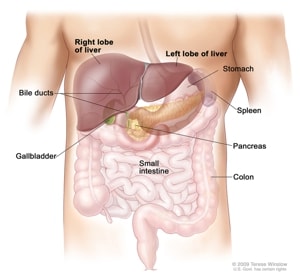Spreading the Word About Hepatitis C and Liver Cancer
New resources are getting the word out about the link between Hepatitis C and liver cancer. Among American Indian/Alaska Native populations, liver cancer incidence and death rates are increasing. Chronic Hepatitis C infection often leads to liver cancer but there is an effective treatment to cure Hepatitis C. The Association of American Indian Physicians recently produced CDC-funded public service announcements (PSAs) to increase awareness in these communities. The culturally-specific PSAs focus on the importance of getting tested and treated for Hepatitis C infection to lower the risk for developing liver cancer. Take a look at the videos.

Anatomy of the liver. The liver is in the upper abdomen near the stomach, intestines, gallbladder, and pancreas. The liver has four lobes. Two lobes are on the front and two small lobes (not shown) are on the back of the liver. Click to see a larger diagram.
© 2010 Terese Winslow LLC, U.S. Govt. has certain rights. Used with Permission. Contact artist at www.teresewinslow.com for licensing.
Cancer is a disease in which cells in the body grow out of control. When cancer starts in the liver, it is called liver cancer. Each year in the United States, about 33,000 people get liver cancer, and about 26,000 people die from the disease. The percentage of Americans who get liver cancer has been rising for several decades.
To lower your risk for liver cancer, get vaccinated against Hepatitis B, get tested for Hepatitis C, and don’t drink too much alcohol.
What Is the Liver?
The liver is the largest organ in the human body, located on the upper right side of the body, behind the lower ribs. The liver does many jobs, including—
- Storing nutrients.
- Removing waste products and worn-out cells from the blood.
- Filtering and processing chemicals in food, alcohol, and medications.
- Producing bile, a solution that helps digest fats and eliminate waste products.
What Causes Liver Cancer?
Many liver cancer cases are related to hepatitis B virus or hepatitis C virus infections. Most people don’t know they have the virus.
Other behaviors and conditions that increase risk for getting liver cancer are—
- Excessive alcohol use.
- Cirrhosis (scarring of the liver, which can also be caused by hepatitis and alcohol use).
- Obesity.
- Diabetes.
- Having hemochromatosis, a condition where the body takes up and stores more iron than it needs.
- Eating foods that have aflatoxin (a fungus that can grow on foods, such as grains and nuts that have not been stored properly).
What Are the Symptoms of Liver Cancer?
In its early stages, liver cancer may not have symptoms that can be seen or felt. However, as the cancer grows larger, people may notice one or more of these common symptoms. It’s important to remember that these symptoms could also be caused by other health conditions. If you have any of these symptoms, talk to your doctor.
Liver cancer symptoms may include—
- Discomfort in the upper abdomen on the right side.
- A swollen abdomen.
- A hard lump on the right side just below the rib cage.
- Pain near the right shoulder blade or in the back.
- Jaundice (yellowing of the skin and whites of the eyes).
- Easy bruising or bleeding.
- Unusual tiredness.
- Nausea and vomiting.
- Loss of appetite.
- Weight loss for no known reason.
How Can I Reduce My Risk for Liver Cancer?
You can lower your risk of getting liver cancer in the following ways—
- Get vaccinated against Hepatitis B. The Hepatitis B vaccine is recommended for all infants at birth and for adults who may be at increased risk.
- Get tested for Hepatitis C, and get medical care if you have it.
- Avoid drinking too much alcohol.
Statistics
The Data Visualizations tool makes it easy for anyone to explore and use the latest official federal government cancer data from United States Cancer Statistics. It includes the latest cancer data covering 100% of the U.S. population.






















.png)











No hay comentarios:
Publicar un comentario